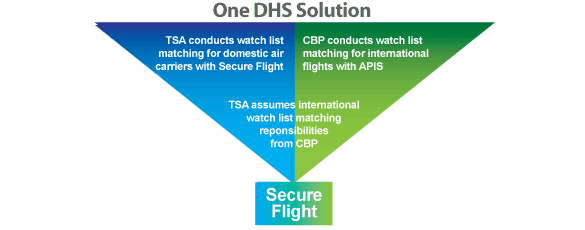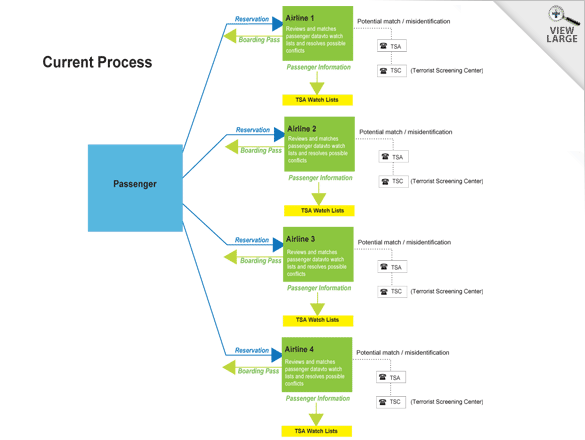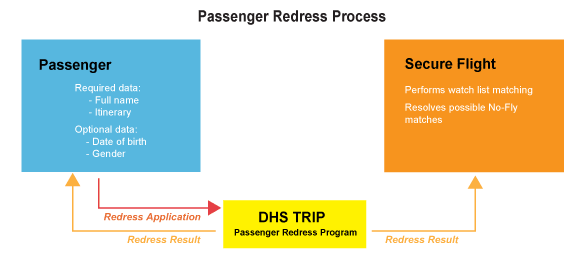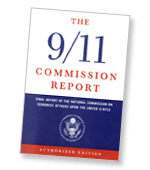Secure Flight Program
Layers of Security
A public meeting was held by the Transportation Security Administration (TSA) regarding the Notice of Proposed Rulemaking (NPRM) entitled "Secure Flight Program" on September 20, 2007.
- Read the public meeting transcript.
- Listen to a replay of the audio webcast.
- Read TSA Administrator Kip Hawley's opening statement.
- Read the notice of public meeting and request for comments. (pdf, 57Kb)
The Department of Homeland Security (DHS) is taking significant steps toward implementing a key 9/11 Commission recommendation - uniform watch list matching by TSA - also known as Secure Flight.
The program is designed to conduct uniform prescreening of passenger information against federal government watch lists for domestic and international flights. Currently, air carriers are responsible for checking passengers against government watch lists.
Under Secure Flight, TSA will receive information for each passenger. TSA will then determine any matches of information with government watch lists and transmit matching results back to aircraft operators. To this end, the TSA has issued the Secure Flight Notice of Proposed Rule Making (NPRM) (3.7Mb, pdf), which lays out the Department of Homeland Security's plans to assume watch list matching.
Secure Flight will match limited passenger information against government watch lists to identify known and suspected terrorists, prevent known and suspected terrorists from boarding an aircraft, facilitate legitimate passenger air travel, and protect individuals' privacy. Secure Flight will:
- Identify known and suspected terrorists;
- Prevent individuals on the No Fly List from boarding an aircraft;
- Identify individuals on the Selectee List for enhanced screening,
- Facilitate passenger air travel by providing fair, equitable and consistent matching process across all aircraft operators; and
- Protect individuals' privacy
The NPRM initiated a public comment period that enabled the traveling public and industry to voice comments and concerns. Initial implementation of Secure Flight is expected to occur in 2008.

In August, 2007, DHS also published the Advance Passenger Information System (APIS) Pre-Departure Final Rule, which enables DHS to collect manifest information for international flights departing from or arriving in the United States prior to boarding. Together with Secure Flight, these measures will strengthen aviation security through uniform and consistent passenger pre-screening against government watch lists. CBP and TSA will combine the Advance Passenger Information System (APIS) and Secure Flight concepts and systems to provide "One DHS Solution" to the commercial aviation industry and the traveling public.
Current watch list process requires multiple airlines to check passenger data
Currently, aircraft operators match passenger reservation data against a watch list provided by TSA so individuals known to pose a threat to aviation are not allowed to fly – period. Through the Secure Flight program, TSA will assume responsibility for this function from aircraft operators.

Secure Flight will improve process and drastically reduce misidentifications
By moving watch list matching responsibilities away from the airlines and centralizing it in-house, TSA will ensure a higher level of consistency and will help remedy possible misidentifications if a traveler's name is similar to one found on a watch list. It is to the passenger's advantage to provide the requested data elements (listed below) as doing so may prevent delays or inconveniences at the airport. This is particularly important for those individuals who have similar names to those on the watch lists or passengers with common names. Failure to provide the additional data elements may result in inconvenience.
Additionally, bringing watch list matching into the government will provide consistent application of an expedited and integrated redress process for passengers that believe they have been misidentified as a threat. Click here for more information about DHS Traveler Redress Inquiry Program (TRIP) to provide a one-stop shop for passengers seeking redress.


Secure Flight ensures security without compromising privacy
Ensuring the privacy of individuals is a cornerstone of Secure Flight. TSA has developed a comprehensive privacy plan to incorporate privacy laws and practices into all areas of Secure Flight. The program has worked extensively to maximize individual privacy.
TSA will collect the minimum amount of personal information necessary to conduct effective watch list matching. TSA published a Privacy Impact Assessment (PIA) and System of Records Notice (SORN) to provide detailed information about the program's privacy approach in conjunction with its NPRM.
TSA requested comments on the data elements through the rulemaking process to determine whether date of birth and gender should be mandatory data elements, and will consider all comments received. TSA will not collect or use commercial data to conduct Secure Flight watch list matching.
Additional Resources
- Read the Press Release
- Specific recommendations in the 9/11 Commission Report
- Secure Flight Notice of Proposed Rule Making (NPRM) (3.7Mb, pdf)
- Advance Passenger Information System Pre-Departure Final Rule (4.5Mb, pdf)
- Secure Flight - Privacy Impact Assessment (222Kb, pdf)
- Secure Flight - System of Records Notice (555Kb, pdf)
- DHS Traveler Redress Inquiry Program (TRIP)
Download Plug-in
Some of the links on this page require a plug-in to view them, which are available below.




